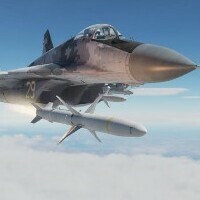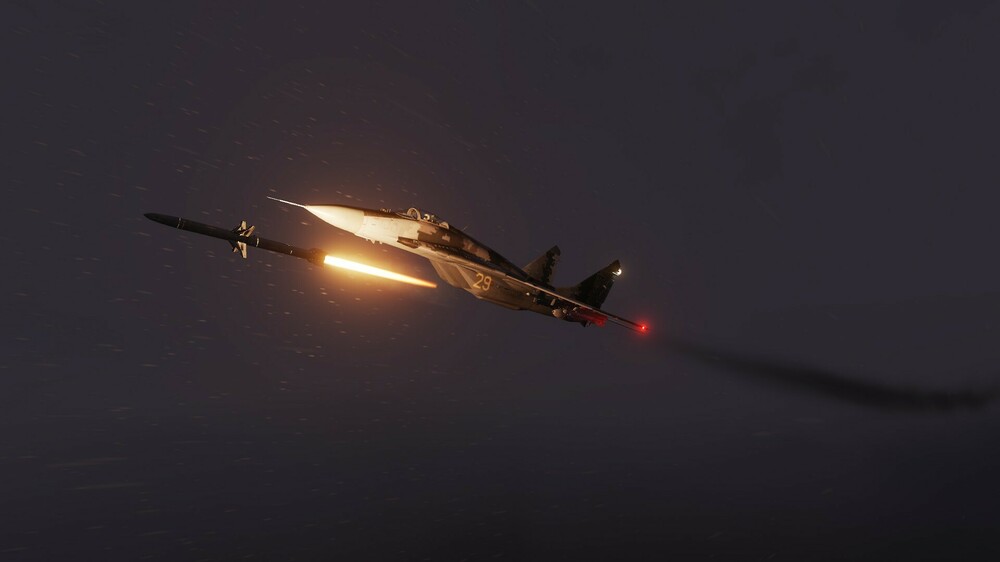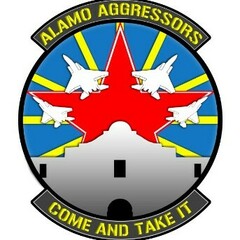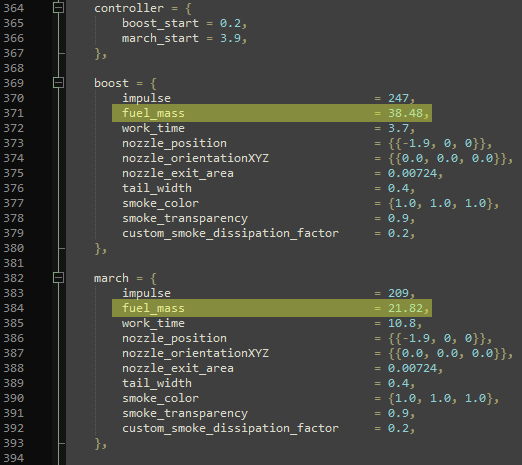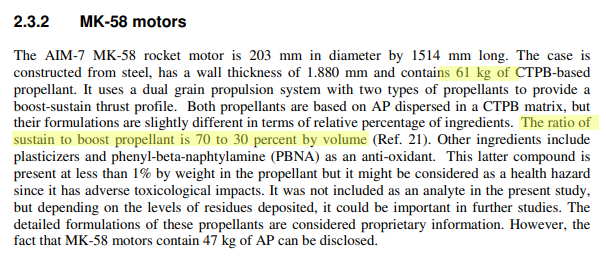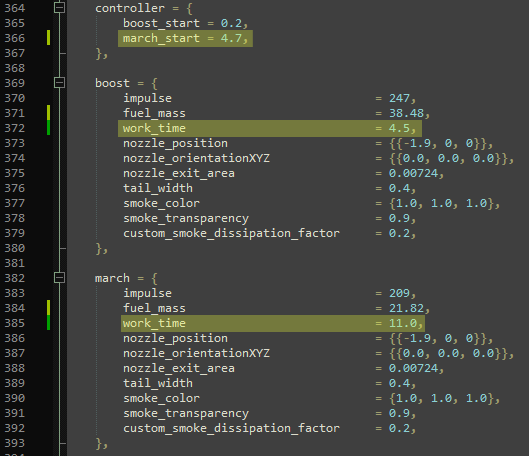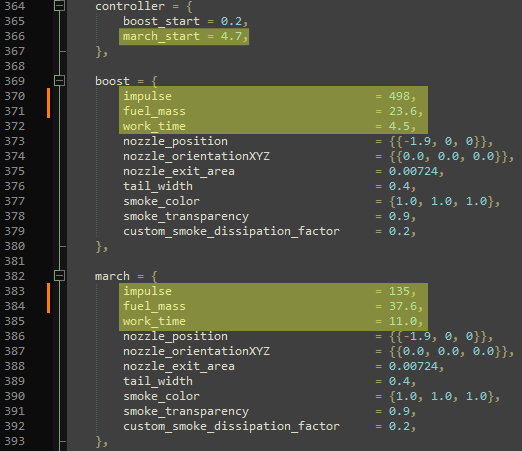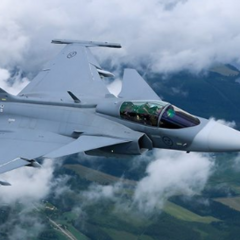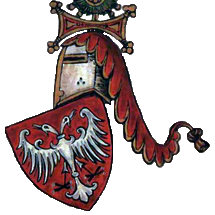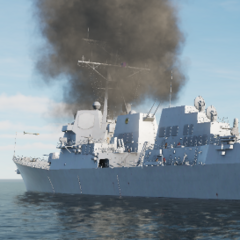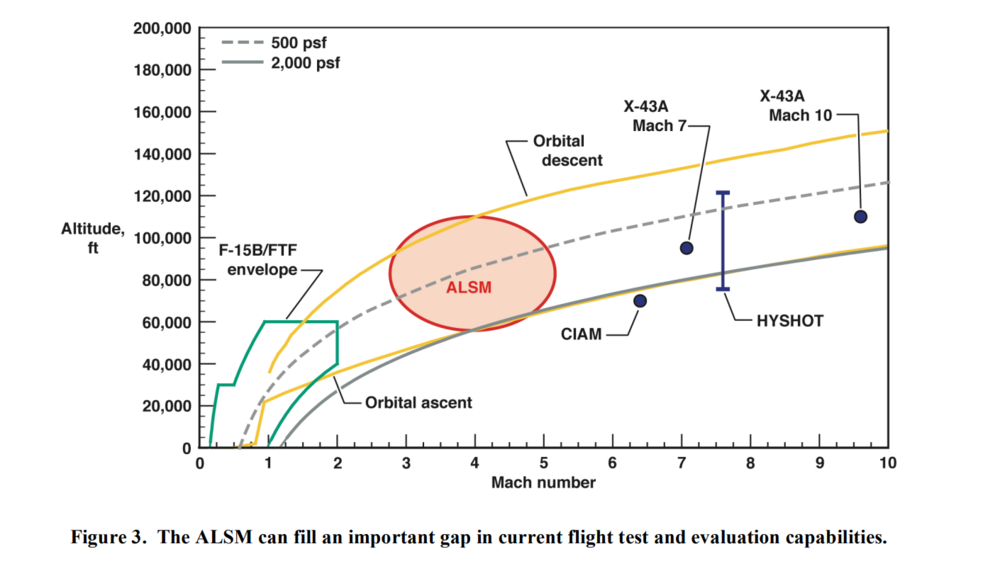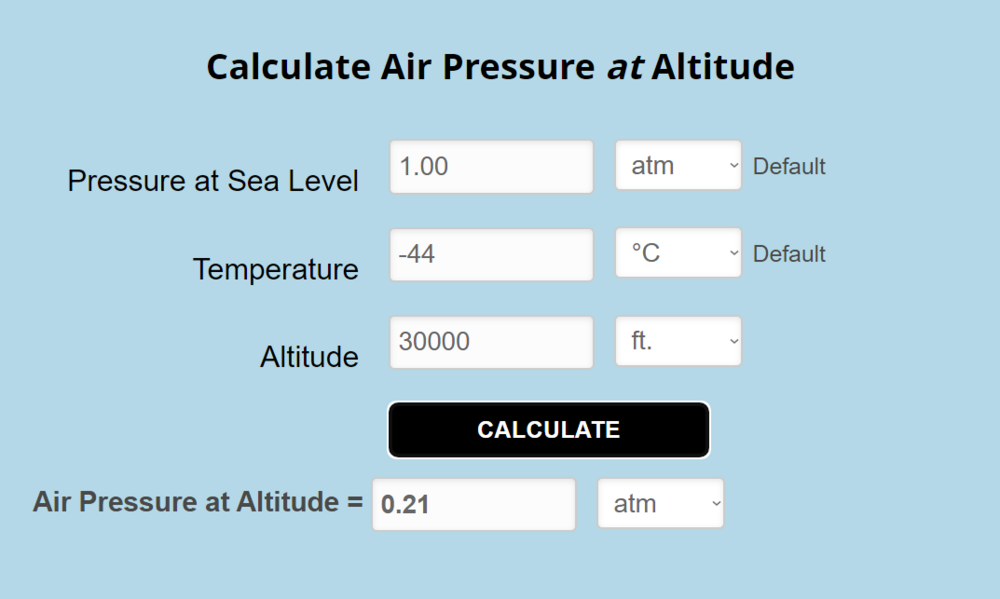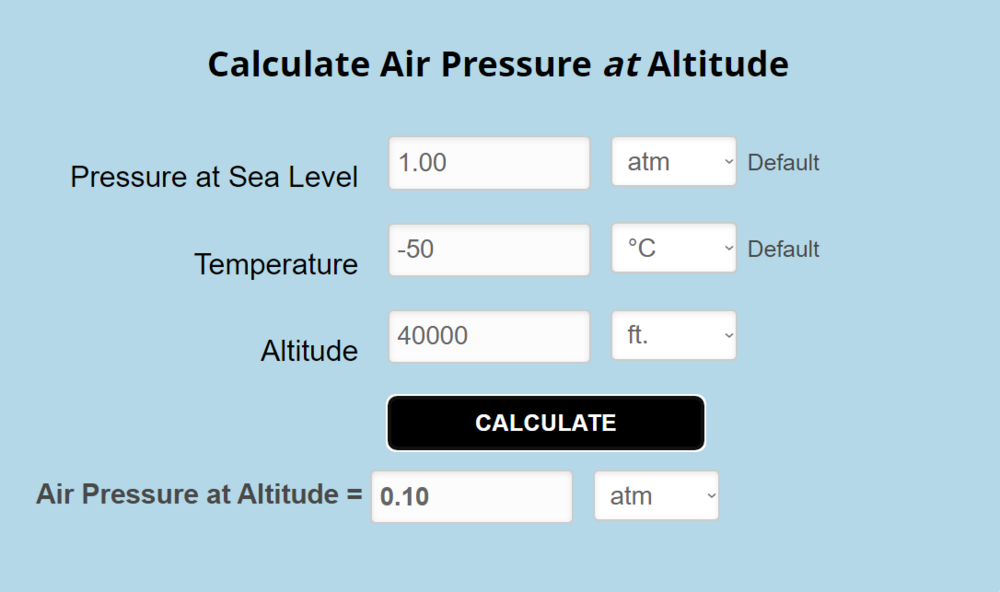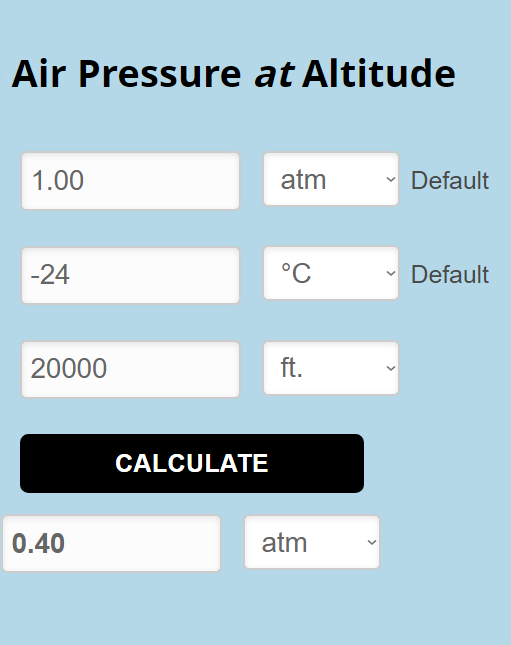Search the Community
Showing results for tags 'missile'.
-
Can we please have AGM-88 HARM SP mode integrated on the Fulcrum? Why? Coolest thing I've ever saw. OK, I admit to doing the same in DCS... just get the SAM - like a @currenthill Panstir to lock on me and I fling the HARMs in SP mode.
-
I've encountered a bug with the Kh-22 - on launch, it clips into the launching aircraft. What seems to happen is that as soon as the ventral fin/rudder unfolds, the missile's control surfaces unlock which then results in the missile climbing through the launching aircraft. I'm not entirely sure what sequence of events should happen when a Kh-22 is launched, but delaying the unlocking of the control surfaces should resolve the issue - which if I'm not mistaken was how it was pre 2.9.0. EDIT: According to this video, the missile appears to free-fall from the launching aircraft, gaining quite a bit of separation before engine ignition (which occurs ~2-2.5 s after launch) and pitch-up. Fortunately, the missile seems to lack a collision model (at least between it and its launching aircraft), so it doesn't lead to damage to the aircraft. The problem happens on all 3 stations (see Kh-22_clipping1.trk for the wing stations, and 2 for the fuselage station). Kh-22_clipping1.trk Kh-22_clipping2.trk
-
A few updates ago(after some version in 2.8.x) , AGM-65 lost its ability of tracking fast-moving targets such as helicopters, while functioning as intended when tracking the slow ones. The Mavs can definately see the target, completely able to track it(target is within the seeker FoV and G limit) , having enough energy to hit, but it just 'refuses' to track it. That disabled the ability of fixed-wing aircraft to attack helicopters using any Mavericks. I have tested out all variant, including TV, IR, and laser guided. It seemed that the problem is at the weapon scheme: I've checked "DCS World OpenBeta\CoreMods\aircraft\AircraftWeaponPack\agm65_family.lua", found that max G of the missile is 16, the seeker Fi shows he can track targets 180° in the front hemisphere, and the 'Omviz' value is 99.9, which indicates a very big LOS velocity, in conclusion, it seemed that Mav's lua file won't stop it to track a fast-moving target. So I doubt it's the scheme, all Mavs share 2 schemes, agm65 or agm65e, now both of them are 'brocken' in some ways. If anyone wants to test it out, try shooting at a heli moving at ~100knots. It would be more obvious if you can ask a friend flying a heli and start accelerating from hover as you fired a maverick at him. At first I thought only the IR and TV seekers are broken. Recently I checked the Laser seeker, it turns out to be no joy either. The Maverick is flying like it lost any purpose, when the heli increase it's speed above threshold, the Mav won't control its rudders and allowing itself to fall.
-
Preface: The main purpose of this post is not to strictly improve the missile performance itself, but to correct values in the AIM-7 missile Lua code that are not accurate to the publicly available information. Any improvement to the performance of the missile should be seen as a side effect and not the intended purpose. This post seeks to compare several public sources on the AIM-7's Hercules MK-58 rocket motor to what is actually modeled in game, and contrast them accordingly. Tests were done using a modified AIM-7F utilizing the "corrected" values to showcase the differences to the vanilla missile. Only the AIM-7F was used for testing as the kinematics between each variant carrying the MK-58 rocket motor are practically negligible. The Tacview files will be provided in this post. The ED AIM-7 vs Public Data: 1. Rocket Motor Burn Time According to ED's missile code (Fig. 1), the AIM-7 has a booster stage burn time of 3.7 seconds, and a sustainer burn time of 10.8 seconds for a total run time of 14.5 seconds not including the 0.2 second delay for the boost ignition and 0.2 second delay for the sustainer ignition. However, according to the "Raytheon AIM-7F Standard Missile Characteristics" data sheet (Fig.2), "AD-A-142508" (Fig.3) and "Gallery of USAF Weapons, 2010 Almanac" (Fig. 4) the stated burn time for the boost stage is 4.5 seconds and the sustainer stage is 11 seconds for a total run time of 15.5 seconds. This is one full second, not including ignition delays, of difference between the ED code and public information. This may be a negligible difference, but there is a conversation about edge cases where the one extra second may matter. Figure 1: Default Eagle Dynamics AIM-7 MK-58 motor code Figure 2: Raytheon AIM-7F Standard Missile Characteristics Engine Ratings Figure 3: AD-A-142508 AIM-7F data sheet Figure 4: Gallery of USAF Weapons, 2010 Almanac AIM-7 data sheet 2. Boost and Sustain Fuel Mass and Mass Ratios Looking at the ED code (Fig.5) boost stage for the MK-58 has a fuel mass of 38.48kg (84.83lbs), and the sustainer stage has 21.82kg (48.10lbs) of propellent for a total mass of 60.3kg (132.9lbs). The sustainer-to-booster propellent mass ratio is approximately 63/37. However, comparing this to the Raytheon propellent masses (Fig. 6) the boost phase contains 52.0lbs (23.6kgs) of propellent and the sustainer fuel mass is 83.0lbs (37.6kg) for a total of 135.0lbs (61.2kgs). The sustainer-to-booster propellent mass ratio with this information is approximately 39/61. The actual masses of propellent in each stage are practically the same with only an error of 7.5%(smaller mass) and 2.3%(larger mass), but reversed in ratio. According to a Canadian study of the Mk-58 Mod 5 rocket motor, there are no listed measurements for the individual propellent masses except for a total fuel mass of 61kg (134lbs). However, the stated sustainer-to-booster propellent mass ratio is 70/30 (Fig. 7) which leads to a booster fuel mass of roughly 18.3kg (40.3lbs), and a sustainer fuel mass of roughly 42.7kg (94.1lbs). Neglecting that the Mod 5 version of the motor may have slightly different masses for each stage, the point stands that the ED MK-58 is coded to have a complete reversal of the publicly available data on the propellent mass and mass ratios for each stage. This will lead to noticeable differences in the performance of each stage as we will see in the test portion of this post. Figure 5: ED AIM-7 fuel mass code Figure 6: Raytheon AIM-7 SMC Fuel data Figure 7: Canadian MK-58 study 3. Boost and Sustain Specific Impulse Values As stated in the ED AIM-7 code (Fig. 8.), the specific impulse for the boost phase of the MK-58 motor is 247 seconds, and 209 seconds for the sustainer phase. Using the ED values, and a gravity value of 9.8 m/s2, we get a boost phase thrust of approximately 25.174kN (5659lbf), and a sustainer phase thrust of approximately 4.138kN (930lbf). Now, according to both the Raytheon AIM-7 SMC (Fig. 2) and the AD-A-142508 (Fig. 3), the stated thrust of the boost phase is 5750lbf (25.577kN), and 1018lbf (4.528kN) for the sustainer. Note that the ED values are underperforming, but can be considered negligible as there is only an error of about 1.6% and 8.6% and motor performance varies with many factors. Using the ED values for both thrust and fuel mass, but correcting the fuel ratios and burn time for each stage, we get a boost phase specific impulse of 530 seconds and sustainer phase of 121 seconds. This is quite a dramatic difference in performance between the actual ED missile and this theoretical "corrected" motor with the boost phase being over twice as efficient, but the sustainer being nearly half as efficient. Now, this may seem as though the performance of the missile may also dramatically improve, but, as we will see in the tests, this is not the case. This is a minimum however as the ED missile uses a lower thrust and fuel mass compared to the public data, so there may be performance left on the table. If we use only public data to formulate the specific impulse of each stage then we get a boost phase of 498 seconds and a sustainer phase of 135 seconds. We will see how this version of the missile compares to the ED one as will. Figure 8: ED AIM-7 specific impulse code In-Game AIM-7F Tests: Test Parameters: Game Version: 2.9.1.48335 Map: Marianas Weather, Date, Time: Mission Editor defaults Launch Platform: F-15C Launch Altitude: ~40,000ft Launch Speed: ~1.5 IMN Target Platform: MiG-19P Target Altitude: ~40,000ft Target Speed: ~1.2 IMN Test 1: Control: Test 2: Corrected Burn Times: Test 3: Corrected Burn Time, ED Fuel Mass, Corrected Ratio: Test 4: Corrected Burn Time, ED Fuel Mass, Corrected Ratio, and Specific Impulse: Test 5: AIM-7F Public Data Only: Conclusions: First, comparing the control missile to the missile from Test 2, we see that the change in burn time yields practically zero difference in peak energy states. However, it can be said that the extra time in the boost phase and overall longer burn time will help in edge cases where a slightly longer burn time would result in better terminal energy. Looking at Test 3, we see that the acceleration observed at each stage is dramatically different where the majority of the acceleration of the missile is felt during the sustain phase rather than the boost phase, and the overall acceleration of the missile is much smoother reminiscent of the AIM-54's motor. Yet, again, the missile does not yield any noticeable improvement to peak energy state, but it can be said that this could perhaps drastically improve the performance of the AIM-7MH and P missiles as the loft maneuver is less than optimal which depletes the effectiveness of the MK-58's boost stage. This is just speculation though. Next, we see that in Test 4 we finally yield some peak energy improvements however small. It is worth noting that the energy graph has now returned to shape of the vanilla missile with the boost phase taking the brunt of the acceleration leg work. Although the gains are small, this would still result in a better missile with the extended burn time and slightly higher peak energy state, however marginal. Finally, we arrive at Test 5 using only public data. This missile yields the best peak energy state gaining as much energy over Test 4 as Test 4 gains over Test 1. Again, the energy graph is practically a replica of the vanilla one in terms of shape. Although the specific impulse of the boost phase is lower than that of Test 4 the sustainer is higher, and this results in the higher energy state as Test 5 would have higher actual thrust values compared to the ED numbers. It is important to note that Test 4 and 5, where the sustainer specific impulses are lower than the vanilla, would indicate that overall performance may be worse against a maneuvering target, but, again, this is just speculation since the test was done against a cooperative target. Overall, ED has done a fair job at replicating the AIM-7's MK-58 motor performance using "incorrect" fuel ratios and specific impulses, but it is unfortunate that it has been done with "incorrect" information. I believe that the closer we can get to real values (as long as they are public, of course) the better the simulation will be. References: 1. Raytheon AIM-7F Standard Missile Characteristics: http://aviationarchives.blogspot.com/2016/08/raytheon-aim-7f-standard-missile.html 2. Gallery of USAF Weapons, 2010 Almanac: https://www.airandspaceforces.com/PDF/MagazineArchive/Magazine Documents/2010/May 2010/0510weapons.pdf 3. AD-A-142508: https://apps.dtic.mil/sti/pdfs/ADA142508.pdf 4. Canadian MK-58 Mod 5 study: https://apps.dtic.mil/sti/pdfs/ADA596430.pdf AIM-7F Corrected Burntime.acmi AIM-7F Vanilla.acmi AIM-7F Public Data Only.acmi AIM-7F Corrected Burntime+Fuel Mass+Impulse.acmi AIM-7F Corrected Burntime+Fuel Mass.acmi
-
Is there a mod for a missile with a conventional warhead ⁓5t or bigger like the South Korean ballistic missile Hyunmoo-V? I know there is because Ive seen videos of it but I was unsuccessful finding one. like this one: Also is there is a SSM nuclear missile that wont destroy the whole planet like 4Mt max? Or any other crazy mods like this hypersonic cruise missile:
-
- cruise missiles
- cruise missile
-
(and 5 more)
Tagged with:
-
Occasionally I get RWR missile warnings while parked on the airport or taxing at low speed toward the runway. This can be observed 2 times in the past 5 mins of this track. Note: i spent most of the time watching the Mig-21 pilot flying, before I turned my engines on. File can be downloaded here: https://file.io/39cxlmQWToWd I suspect there is either an issue with one of the fox-1 or fox-3 missiles on blue side or problem with J-11A/Flanker RWR. Reference to locally stored file (in case the above link gets removed): Server_1_Operation_Urban_Thunder_V6.6.9-20211202-210739.trk
-
The old AIM-9B had a very simple spin scan seeker that caused its characteristic 'sidewinding' motion. Later variants had different seekers that conferred different behaviors which are not currently accurately simulated; countermeasure resistance, multi-aspect behavior, etc. Radar-guided missiles that used conical scanning also exhibited these not perfectly straight paths. Accurate missile seeker simulation would greatly improve the behavior of weapons in DCS.
-
We all know jester attempts to switch to P-STT when closing into 10 mile ACM range. And we all know the most common follow-up call is i've lost lock. Annoying if you dont have a missile in the air but not terrible, However if you have a missile in the air and you lose lock... Is there any chance that a) Jester losing lock can be checked to ensure its realistic (a human rio seams to be heaps better at maintaining lock, and b) Jester not changing STT modes while a missile is in the air? Thanks
-
I haven't seen much reporting of this issue, or at least no reporting of it as of late. These problems have been affecting the F-14 for several months now. 1. The AIM-7F does not guide when launched outside of 5-6NM from a target. They will never guide and just come off the rail as if they're dead.AIM-7F test.acmi 2. The AIM-7M lofts at most ranges even though it of course shouldn't be lofting as the MH is the only one that should be. AIM-7M test.acmi So I want to know where in the pipeline are the fixes for these bugs are? I can understand that this has not been a top priority as everyone would rather use a phoenix missile and I know you guys at HB are working on further improvements to it. But the bugs on the sparrow make them essentially useless on the Tomcat when they are a mainstay of the jet. Are there fixes in the works? Is this at least being considered? Or am I simply way off base here by asking HB about this and should instead direct it to ED?
-
Hi everyone, Tried to google on the issue but no joy so far. Me flying with my RIO, engaging an airplane with target size set to medium, TTI starts to flash at 16 sec to impact, all good, good kill. Next shot, exactly the same settings, missile never activates, flies right past the target. Next shot, exactly the same settings, missile activates at 5 sec TTI. In Single player with Jester missile consistantly goes pitbul at 16 sec tti. All shots made in TWS Auto. Is it us doing something wrong or is it multiplayer issue? No track at the moment, they're too heavy and lengthy. Thanks all for your input Regards, Roman
-
Can the SS-1C Scud Launcher be re-armed in mission, or is it single fire per mission? If it can be rearmed, which support unit needs to be placed with it to do this?
-
Any chance we could see improvements to the DCS JF-17 such as a functioning HMD and, I know this is asking for a lot but what about the off-bore sight PL-10E missile? I mean, Deka did make a JF-17 for DCS and no where does it say exactly which block it's meant to be. Sure some say it's block I with some block II features, but we do have a HMD button in the cockpit. I understand majority of block III is classified but maybe some features could make it in, such as HMD.
-
Hi everyone, Found a bug with the ships in DCS that I couldn't see reported before. Very simply, when firing anti-ship missiles, ships don't obey release quantities nor do they obey max attack quantities. In the track below I've got a La Combattante IIa that is set-up to attack a Krivak II. I want the La Combattante IIa to fire a single missile at the Krivak II. To do this I've set the release quantity of anti-ship missiles to 1, and the max attack quantity 1, i.e; make 1 attack, firing a single missile. Instead it keeps firing missiles until the Krivak II has sunk/been destroyed. Firing 2 salvos of 2 missiles each (with 25 seconds between each missile, and the 2nd salvo firing after the missiles of the first salvo have hit). It gets especially bad when you have a ship with lots of missiles firing against a smaller ship, or when firing against a ship that can't really defend itself, that doesn't require lots of missiles to sink - in both cases it leads to them being pretty wasteful with the missiles. AShM_Max_Fire.trk
- 4 replies
-
- ai
- mission editor
-
(and 3 more)
Tagged with:
-
Hello I would like to bring up Ataka weight. There seems to be some pretty widespread disagreement along online sources. Some say 33.5 kg, some say 42.5 kg (as it is in DCS), and some say 49.5 or incorrectly say 48.5. Upon further research you would find multiple sources claiming it is 49.5 kg in the container, whereas in DCS it is 57.5 kg in the container tube http://www.airwar.ru/weapon/aat/ataka.html However, the container is known to be 15 kg, which is what it is in DCS as well with the rack being 13 kg. This would mean that if weight in container was 49.5 kg, actual missile weight would be 33.5 kg. There is a textbook that appears to claim the only difference between Shturm and Ataka is warhead, “Конструкция Средств Поражения, Боеприпасов, Взрывателей И Систем Управления Средствами Поражения: Конструкция и функционирование ПТУР" (Design of Weapons, Ammunition, Fuses, and Control of Destructive Devices: Design and Functioning of ATGMs) by the Penza Artillery Engineering Institute.” And since the 9M120 Ataka warhead is 2 kg heavier then Shturm warhead, and Shturm is 31.5 kg. That brings you to 33.5 kg. There is mentions of 9M120 Ataka being 33.5 kg in this article written by Roy a Broybook in 2005, available here for free viewing https://www.thefreelibrary.com/Weapons+for+whirlybirds-a0138143048 It is also mentioned here as weight of the Ataka being 33.5 kg, but a source is not given. The many sources in the rest of the article especially including Shturm/Ataka make me believe there has to be some reason for the author to have settled on 33.5 kg. Surprisingly they also make the same 48.5 kg mistake for weight inside container. https://thesovietarmourblog.blogspot.com/2021/07/soviet-atgms.html?m=1 Interestingly enough there also English language sources saying weight of Ataka is 42.5 kg as it is in DCS. https://odin.tradoc.army.mil/WEG/Asset/9M120_Ataka_(AT-9_Spiral-2)_Russian_Anti-Tank_Guided_Missile_(ATGM) http://www.military-today.com/missiles/ataka.htm I don’t have much else to say other then, a Mi-24V IE manual makes it known that Ataka average speed is slower then Shturm. Currently in DCS, the Ataka has its rocket power slightly changed from Shturm, I assume to make up for the weight, wether that is based on reality or trying to replicate its real world performance I do not know. I only mention this to say that, if Ataka weight is lowered from its current 42.5 kg to 33.5 kg if ED finds that to be correct, I would hope that the performance still falls within the acceptable region for ED’s standards of realism. I apologize for all the bug reports, but as there seems to be a renewed push to finish Mi-24 and polish it. It seems this is the time to go through details and see if there is anything that can be made better
-
Hi Everyone, I was doing some tests with the Rapier and it seems that when firing at low altitude targets, the Rapier missile will do an extreme yoyo, going high, and then rapidly diving, only barely managing to pull-up and avoid a collision with the ground. In the first track I have a Mi-24V flying near enough perpendicular (but not notching), a launcher and an optical tracker, with no blindfire. The Mi-24V is @200m AGL (ΔH ~ 195m), flying at 200kph - well within the engagement parameters for Rapier (according to the Rapier_FSA_Launcher.lua the minimum altitude is 50m). The first missile climbs, then performs a steep dive, only barely managing to pull-up to avoid a collision with the sea, and eventually hits the target. The target descends, another Rapier is fired, this time crashing into the sea. The third missile repeats what the first missile did, and barely manages to avoid colliding with the sea. In the second track I have everything set-up exactly the same, only now the helicopter is set to an altitude of 100m (ΔH ~95m), which should still be inside the Rapiers engagement altitude; this time every missile ends up flying into the water. It should be noted that the missile behaves the same when paired with Blindfire or not. Now this could be caused by probably 1 of 4 factors: The missiles are initially elevated too high - unlikely, the missiles should elevate based on range and altitude. The missiles are too aggressive in trying to centre themselves in the operators reticule (this is broadly what an optical SACLOS guidance scheme tries to do) - unlikely as this might play a part into reducing the minimum range, which is probably a good thing for a short ranged system. The missiles aren't responsive/manoeuvrable enough - not sure, I can only base on my expectations (which may well be off). If you draw a line between the optical tracker and the target I'd expect the missile to follow that line more closely (like the Tunguska), not loft way high above it and then make an excessive dive past it. The AI operator - here I think lies the issue, the AI operator most likely keeps the reticule as centred as possible on the target, this makes sense, however it is most likely (from my reckoning at least) causing this issue, if not for the above 3; a possible remedy is to have the operator aim high (at a similar elevation to the one the missiles are fired at), and then slowly bring the reticule down (so that it is on the target after about 2 seconds). Hopefully, this will result in a more gradual descend and the missile won't perform such an aggressive dive that it can barely climb away from. This should also increase the amount of energy the missile has, which is beneficial for achieving a hit. There is this video of a Rapier launch failure (here the system is the much more modern FSC variant, but AFAIK the command-guidance scheme is the same, just instead target tracking is done automatically via EO/IR and/or RADAR). In DCS it seems to do something similar every time it's launched at a low-altitude target. Can anyone confirm what's going on here, and how Rapier should behave? I've done some digging but can't find much, other than basics. [sidenote: @Tippis contrary to your excellent reference wiki Rapier in DCS will in fact launch with just the optical tracker and without Blindfire, under an optical SACLOS guidance scheme, as it should IRL]. Rapier_FSA_Guidance_(200m_AGL).trk Rapier_FSA_Guidance_(100m_AGL).trk
-
I've been playing for a few days now. I've done all the training for the SU-25 and have pretty good understanding of how the plane and weapon systems work. I loaded into my first mission which is a escort/search and destroy mission. first time I couldn't get the LA for anti radar missiles no matter what range I was at and then lost my lock and couldn't get it back. figured I had done something wrong. I have replayed the anti radar training multiple times and know I'm doing everything right. everything works well in the training but when it comes mission time I still cant get the LA to fire. I figured out the lock issue but I still cant get weapons the fire. step by step I fly for 20 minutes on auto pilot. get enemy radar contact. turn off auto pilot. switch to air to ground mode. turn on targeting pod. make sure Anti radar missiles are selected. lock on radar signature. make sure range carrot is within parameters. squeeze trigger and nothing. idk what's going on. I'm sure its user error but idk what I'm doing wrong I'm following the training to a T and its not working. thanks in advance.
-
BLUF, I would like to see SAM’s better modeled within DCS. I’ll be speaking primarily about the SA-2 but the points I bring up apply to other SAM’s in the game. There are a few things on the in-game SA-2 that are modeled but not function such as the trough antennas on the Fan Song Target Engagement Radar (TER) that allow it to do its own limited search function. These antennas can scan a fixed area at a time or be combined with the rotation of the whole unit to provide 360 degrees of search. Another thing missing on the Fan Song is its optical tracker. This allowed crews to track targets without the use of the 2 parabolic dish antennas mounted on top. Since the missile guidance was accomplished using Command Guidance instead of Beam Riding the target aircraft wouldn’t get a missile launch warning until the beam from the missile uplink antenna also encompassed the aircraft. This is also true for when crews tracked targets using the Radars, the aircraft would be alerted via its RWR (Radar Warning Receiver) that it was being locked onto, but the missile launch alert would not be given until the aircraft was in the same beam as the missile. For a brief explanation of why this happens continue reading this paragraph, if you already have a grasp of it feel free to skip to the next one. On radar's like the Fan Song that use command guidance, there will usually be antennas dedicated to tracking a target and antennas dedicated to missile guidance or, "talking to the missile." Because the radar's goal is to get the missile out in front of the aircraft to pull lead and not waste its limited energy, it will be fired with lead and the narrow beam of energy pointed at it to give it commands during flight will likely not encompass the aircraft until the missile and aircraft are very close (this scenario assumes a side aspect shot). The aircraft will be kept in the beam of a tracking antenna that works with a computer or the operator to tell the uplink how to guide the missile. The optical tracker is seen on most "E" models of the Fan Song radar which is the variant modeled in game, this is evident by the placement of the 3 parabolic dishes as well as the trough antenna's. From what I have read the SA-3's Low Blow radar includes similar trough antennas however it does not utilize them in the same search function, instead they act as receivers. These Trough antennas are fixed in place so they are limited in azimuth and elevation in terms of search capability, however the inclusion of these antennas mean systems like the SA-2 are not completely useless if the search radar is offline. Something to note is the choice of search radar for the SA-2 and SA-3 being the P-15 Flat Face in game. In real life as far as I've read the P-18 Spoon Rest was the intended Search Radar for at least later model SA-2’s such as the “D” model we have in game. It was also used with the SA-3, however the SA-3 also used a later version of the P-15 called the P-15M Squat Eye. Both the Spoon Rest and the Squat Eye include better performance over the Flat Face. Something that I cannot confirm (as I do not know how the guidance is modeled) but suspect to be inaccurate is the flight path taken by missiles using command guidance. Rather than being fired and leading the target they seem to lag behind it or travel directly to it as if they were beam riding. My final point on the SA-2 specifically is the maximum range of the system. The Target Tracking radar is the SNR-75M4 Fan Song E (it could also be the SNR-75M3 Fan Son E I have not been able to distinguish between the two systems based on our in-game model). The variant of SA-2 to use Fan Song E’s was the SA-2D which used the 5Ya23 missile. This missile has a maximum range of 76,000 m or 41.04 NM. The missile in game has a maximum range of 28 miles, which while being a more realistic firing range as it's much closer to the "no escape" range of the missile, is still short of the maximum range. It's important to note that the statistics for the type of missile used in game seem to be relatively accurate, I believe it is just the wrong missile being used for the variant of SA-2 we have. To conclude, I would like to see track radars have expanded functionality to match their real world counterparts, the variant of SAM specified (like SA-2B, SA-2C, SA-2D etc...) and the components and missiles of SAMs used in game synchronized and their specifications brought in line with the appropriate variant. Thank you and Happy Holidays Sources: http://www.ausairpower.net/APA-Engagement-Fire-Control.html http://www.ausairpower.net/APA-S-75-Volkhov.html Both sources include other links to information
-
Issues with SCUD-B & Silkworm launching. Hello. I am quite new to the missiles such as the Silkworm and the SCUD-B. I can't figure out how to launch the Silkworm and the SCUD-B. I select the fire at point for the SCUD-B and attack group (ship) options, but they do not seem to fire. Would mean a lot for me to get help and educate myself on how to use these missile launchers in-game with AI. Best regards, polak_3
-
Specific Impulse is calculated like this: https://www.grc.nasa.gov/www/k-12/airplane/specimp.html It will be called "Isp" from here on. The Isp therefore calculates from Game Files like this: 13595N / ((163kg/27s) * 9,81m/s )= 229,554s As a Comparison, the Space Shuttles Solid Rocket Boosters Isp was 242s on Ground level, 268s in Vacuum. Source: https://en.wikipedia.org/wiki/Space_Shuttle_Solid_Rocket_Booster?fbclid=IwAR0U76UEI_XSu9uyMmW-ieV7sorH4y-cTmtCPLeXGUVowO2t_1LMh3T8ii4#:~:text=This propellant is commonly referred,%2Fs As visible in the Files, it currently works with a specific thrust that is not changing with Air Pressure, even tho it should. Source: https://www1.grc.nasa.gov/beginners-guide-to-aeronautics/thrust-force/#general-thrust-equation-for-rocket-engines Furthermore, the Missile does currently NOT reach close to its Specification, as specified in the two Sources below (see "New Air-Launched Small Missile (ALSM) Flight Testbed forHypersonic Systems" and "SubA_6_2_Phoenix Project Overview"). Source: "nullNew Air-Launched Small Missile (ALSM) Flight Testbed for Hypersonic Systems" Source: "SubA_6_2_Phoenix Project Overview" Furthermore, both Rocket Motors share the same Isp, even tho one is Smokeless and the other one is Smoking (!!!) This is very unlikely, given smokeless propellants usually have Isp Drawbacks. Proposed Solution: Currently, the Aim-54 Isp and Max. Mach Speed are too low compared to the real world without a doubt. Increasing the Thrust (and therefore Isp) by: 5% for the MK60 Motor at Ground level 0% for the MK47 Motor at Ground level would put the MK60 Motor at 241,03s of Isp, about on par with the Space Shuttles Solid Boosters. Most important however is the (currently missing) additional Dynamic Thrust by Altitude: Both Boosters should gain extra Thrust of 268s/242s = ~11% when in Vacuum, so using the Barometric Formula for Air Density at Altitude both Motors should achieve a higher thrust of: 3,74% burning at 10000 feet (see Math below) 6,6% burning at 20000 feet (see Math below) 8,69% burning at 30000 feet (see Math below) 9,9% burning at 40000 feet (see Math below) Math: 10000 feet: 1atm - 0.66atm = 0.34atm, 0.34 * 11% = 3,74% 20000 feet: 1atm - 0.40atm = 0.60atm, 0.6 * 11% = 6,6% 30000 feet: 1atm - 0.21atm = 0.79atm, 0.79 * 11% = 8,69% 40000 feet: 1atm - 0.10atm = 0.90atm, 0.9 * 11% = 9,9% Source: https://www.mide.com/air-pressure-at-altitude-calculator & https://en.wikipedia.org/wiki/Barometric_formula For Testing, I have modified my Game Files to match the Math: The MK60 Missile would now reach Mach 4.5 instead of its previous Mach 3.8 when launched at 40000 feet, bringing it right to where it should be, according to both Sources ("New Air-Launched Small Missile (ALSM) Flight Testbed forHypersonic Systems" and "SubA_6_2_Phoenix Project Overview"). Thank you for taking the time to read and assess this, Dear Reader Best Wishes, Florian (Student and future Engineer of the Aerospace Engineering Branch) New Air-Launched Small Missile (ALSM) Flight Testbed forHypersonic Systems.pdf SubA_6_2_Phoenix Project Overview.ppt
-
Hello all! The AIM-7 Sparrow (Airbourne Interception Missile) is a radar guided air to air missile, it used alongside the famous AIM-9 sidewinder and also infuenced aerial combat quite alot. it was the forefront of todays BVR combat. In the begining and a brief explaination of how the AIM-7 works unlike the AIM-9 sidewinder, the AIM-7 uses radiowaves to guide to its target, im going to explain how its done: The Sparrow Evolution and Performance Thanks to MacedonianSukhoi for the image. -------------------------------------------------------------------------------------------------------------------------- AIM-7A - Sparrow I The history of the Sparrow missile dates back to 1947, when the U.S. Navy contracted Sperry to develop a beam-riding guidance system for a standard 12.7 cm (5 in) HVAR (High Velocity Aerial Rocket). The original designation for this missile project was KAS-1, but this was changed to AAM-2 in September 1947 and to AAM-N-2 in early 1948. The 5" diameter soon proved to be too small, so Douglas developed a new airframe of 20.3 cm (8 in) diameter. The first unpowered flight tests of XAAM-N-2 prototypes occurred in 1948. Development was difficult, however, and the first successful air-to-air interception was only done in December 1952. The AAM-N-2 Sparrow I entered service in 1956 with F3H-2M Demon and F7U-3M Cutlass fighters. Because of the inherent disadvantages of beam-riding guidance, like poor low-level performance, only 2000 Sparrow I missiles were produced, and it was withdrawn from service after only a few years. Another drawback of the AAM-N-2 was that the guidance beam was slaved to an optical sight in the aircraft, which necessitated visual identification of the target, making the Sparrow I a short-range VFR missile only. Performance AIM-7A Length: 3.74 m (147.3 in) Finspan: 0.94 m (37 in) Diameter: 20.3cm (8 in) Weight: 143 kg (315 lb) Speed: Mach 2.5 Propulsion: Aerojet 1.8KS7800 solid rocket Thrust: 7100lbs (3220kg) for 2.04sec Guidance duration: N/A Warhead: 20 kg (45 lb) EX25 Mod.0 warhead with 4.2kg (9.25lbs) of H.6 Detonation distance: 7.6m (25ft) Guidance type: Beam Riding Maneuvering capability: N/A Max Launch velocity: Mach 1.3 -------------------------------------------------------------------------------------------------------------------------- AIM-7B - Sparrow II Because of the above noted principal problems of the AAM-N-2, new guidance methods were searched almost from the beginning. As early as 1950, Douglas studied the possibility of equipping the Sparrow with a active radar-homing seeker. By 1955 Douglas proposed going ahead with development, intending it to be the primary weapon for the F5D Skylancer interceptor. It was later selected, with some controversy, to be the primary weapon for the Canadian Avro Arrow supersonic interceptor, along with the new Astra fire-control system. For Canadian use and as a second source for US missiles, Canadair was selected to build the missiles in Quebec. The small size of the missile forebody and the K-band AN/APQ-64-radar limited performance, and it was never able to work in testing. After considerable development and test firings in the U.S. and Canada, Douglas abandoned development in 1956. Canadair continued development until the Arrow was cancelled in 1959. Performance AIM-7B Length: 3.65 m (144 in) Finspan: 1.02 m (40 in) Diameter: 20.3cm (8 in) Weight: 190 kg (420 lb) Speed: Mach 2,67 Propulsion: Aerojet 1.8KS7800 solid rocket Thrust: 8000lbs (3628kg) for 1.84sec Guidance duration: N/A Warhead: 20 kg (45 lb) Detonation distance: 7.6m (25ft) Guidance type: Active Radar Homing (ARH) (active) Seeker range: 12km (6NM) Aerodynamic Range (50kft alt): 28km Maneuvering capability: 20g Max Launch velocity: Mach 1.3 -------------------------------------------------------------------------------------------------------------------------- AIM-7C - Sparrow III After the failure of the Sparrow II program other ways of guidance where considered. The development of the modern sparrow started in 1955 by raytheon. The Sparrow III and all subsequent versions of Sparrow used semi-active radar homing. After tests with YAAM-N-6 R&D missiles, production of the tactical AAM-N-6 began in January 1958, and it entered service in August 1958. The missile had an Aerojet solid-fueled rocket motor, and a 30 kg (65 lb) MK 38 continuous-rod warhead. Performance AIM-7C Length: 3.66 m (144 in) Finspan: 1.02 m (40 in) Diameter: 20.3cm (8 in) Weight: 172 kg (380 lb) Speed: Mach 4 Propulsion: Aerojet 1.8KS7800 solid rocket Thrust: 7100lbs (3220kg) for 2.04sec Guidance duration: 75 sec Warhead: 30 kg (65 lb) MK 38 continuous rod with 9kg (20lbs) of PBXN-4 Detonation distance: 7.6m (25ft) Guidance type: Semi Active Radar Homing (SARH) Seeker range (200W radar output): 12 km (6.5 NM) Aerodynamic Range (40kft alt): 18 km (10 NM) Maneuvering capability: 16g Max Launch velocity: Mach 1.3 -------------------------------------------------------------------------------------------------------------------------- AIM-7D Sparrow III The AAM-N-6a (AIM-7D) was similar to the -6, but used a new Thiokol liquid-fuel rocket engine for improved performance. It also included changes to the guidance electronics to make it effective at higher closing speeds. The -6a was also selected to arm the Air Force's F-110A Spectre (F-4 Phantom) fighters in 1962, known to them as the AIM-101. It entered production in 1959, with 7500 being built. Performance AIM-7D Length: 3.66 m (144 in) Finspan: 1.02 m (40 in) Diameter: 20.3 cm (8 in) Weight: 197 kg (435 lb) Speed: Mach 4 Propulsion: Thiokol MK 6 MOD 3 (LR44-RM-2) liquid-propellant rocket motor Thrust: N/A Guidance duration: 75 sec Warhead: 30 kg (65 lb) MK 38 continuous rod with 9kg (20lbs) of PBXN-4 Detonation distance: 7.6m (25ft) Guidance type: Semi Active Radar Homing (SARH) Seeker range (200W radar output): 15 km (8.3 NM) Aerodynamic Range (40kft alt): 44 km (24 NM) Maneuvering capability: 15g Max Launch velocity: Mach 2.2 -------------------------------------------------------------------------------------------------------------------------- AIM-7E Sparrow III In 1963, production switched to the AIM-7E version. It used a new propulsion system, a solid-fueled rocket by Rocketdyne (either a MK 38 or later a MK 52). The new motor again significantly increased range and performance of the missile. Effective range of course depended greatly on firing parameters like launch speed and relative velocity of the target. In head-on attacks under optimal conditions, it could be as high as 35 km (20 nm), while in stern attacks, maximum effective range was more around 5.5 km (3 nm). About 7500 AIM-7D and 25000 AIM-7E missiles were built, and the Sparrow was used heavily in Vietnam by the USAF and the U.S. Navy. The first combat kill was scored on 7 June 1965, when USN F-4B Phantoms shot down 2 MiG-17s. However, the initial combat results were very disappointing. The potentially long range of the AIM-7 could not be used, because unreliable IFF capabilities of the time effectively required visual identification of all targets. Coupled with the high minimum range of the missile of 1500 m (5000 ft) and poor performance against manoeuvering and/or low-flying targets, this led to a kill probability of less than 10%. Therefore, the improved AIM-7E-2 was introduced in 1969 as a "dogfight missile". It had a shorter minimum range, clipped wings for higher manoeuverability, and improved autopilot and fuzing. The AIM-7E-3 had further improved fuzing and higher reliability, and the AIM-7E-4 was specially adapted for use with high-power fighter radars (like the F-14's AN/AWG-9). Despite all problems, more than 50 aircraft were shot down by Sparrow missiles during the Vietnam air war. Performance AIM-7E Length: 3.66 m (144 in) Finspan: 1.02 m (40 in) Diameter: 20.3cm (8 in) Weight: 197 kg (435 lb) Speed: Mach 4 Propulsion: Rocketdyne MK 38/MK 52 solid rocket Thrust: 7600lbs (3447kg) for 2.9 seconds Guidance duration: 75 sec Warhead: 30 kg (65 lb) MK 38 continuous rod with 9kg (20lbs) of PBXN-4 Detonation distance: 9.1m (30ft) Guidance type: Semi Active Radar Homing (SARH) Seeker range (200W radar output): 25 km (13.5 NM) Aerodynamic Range (40kft alt): 50 km (27 NM) Maneuvering capability: 25g Max Launch velocity: Mach 2.2 -------------------------------------------------------------------------------------------------------------------------- AIM-7F Sparrow In January 1972, Raytheon began development of the vastly improved AIM-7F. It featured a new dual-thrust (boost/sustain) rocket motor (usually a Hercules MK 58, but sometimes an Aerojet MK 65), which greatly increased the missile's range. The AIM-7F also had a completely new solid-state electronic guidance and control system (GCS), designated AN/DSQ-35, which was also compatible with modern pulse-doppler radars. Continued improvement of the GCS resulted in versions from AN/DSQ-35A through -35H (used in the AIM-7F-11). The smaller GCS permitted the use of a larger 39 kg (86 lb) MK 71 warhead in the new WAU-10/B warhead section. Production began in 1975, and continued through 1981. With the AIM-7F, the official name of the missile was changed from Sparrow III to plain Sparrow. Performance AIM-7F Length: 3.66 m (144 in) Finspan: 1.02 m (40 in) Diameter: 20.3cm (8 in) Weight: 231 kg (510 lb) Speed: Mach 2.9 Propulsion: Hercules MK 58 dual-thrust solid rocket Thrust: Boost 5750lbs (2608kg) for 4,5 seconds Sustain 1018lbs (461kg) for 11 seconds Guidance duration: 75sec Warhead: 39 kg (86 lb) MK 71 continuous rod Detonation distance: 12.2m (40ft) Guidance type: Semi Active Radar Homing (SARH) Seeker range (200W radar output): 40 km (22 NM) Aerodynamic Range (40kft alt): 98km (53 NM) Maneuvering capability: 25g Max Launch velocity: Mach 2.5 -------------------------------------------------------------------------------------------------------------------------- AIM-7G Sparrow The AIM-7G was a version with a new seeker, developed for the USAF around 1970 for use by the F-111D aircraft. A few YAIM-7G prototype missiles were built, but this version did not enter production. -------------------------------------------------------------------------------------------------------------------------- AIM-7M / P / R Sparrow The next version of the AIM-7 was the AIM-7M, whose main new feature was the new inverse monopulse seeker for look-down/shoot-down capability in a new WGU-6/B (later WGU-23/B) guidance section. There is no evidence of any Sparrow variants officially designated -7J/K/L (although the designation AIM-7J is sometimes associated with the AIM-7E license-built in Japan). Source [2] says that the suffix "M" was deliberately chosen to mean "monopulse", suggesting that suffixes J/K/L were indeed skipped. The monopulse seeker improves missile performance in low-altitude and ECM environments. Other new features of the AIM-7M are a digital computer (with software in EEPROM modules reprogrammable on the ground), an autopilot, and an active fuze. The autopilot enables the AIM-7M to fly optimized trajectories, with target illumination necessary only for mid-course and terminal guidance. The AIM-7M also has a new WDU-27/B blast-fragmentation warhead in a WAU-17/B warhead section. The first firing of a YAIM-7M occured in 1980, and the AIM-7M entered production in 1982. The AIM-7P is similar in most ways to the M versions, and was primarily an upgrade program for existing M-series missiles. The main changes were to the software, improving low-level performance. A follow-on Block II upgrade added a new rear receiver allowing the missile to receive mid-course correction from the launching aircraft. Plans initially called for all M versions to be upgraded, but currently P's are being issued as required to replace M's lost or removed from the inventory. The final version of the missile was to have been the AIM-7R, which added an infrared homing seeker to an otherwise unchanged AIM-7P Block II. A general wind-down of the budget led to it being cancelled in 1997. Performance AIM-7M / P Length: 3.66 m (144 in) Finspan: 1.02 m (40 in) Diameter: 20.3cm (8 in) Weight: 231 kg (510 lb) Speed: Mach 4 Propulsion: Hercules MK 58 dual-thrust solid rocket Thrust: Boost 5750lbs (2608kg) for 4,5 seconds Sustain 1018lbs (461kg) for 11 seconds Guidance duration: 75sec Warhead: 39 kg (86 lb) MK 71 continuous rod Detonation distance: 12.2m (40ft) Guidance type: Semi Active Radar Homing (SARH) Seeker range (200W radar output): 40 km (22 NM) Aerodynamic Range (40kft alt): 98km (53 NM) Maneuvering capability: 30g Max Launch velocity: Mach 2.5 Sources: Text based (and some performance): http://www.designation-systems.net/dusrm/m-7.html https://en.wikipedia.org/wiki/AIM-7_Sparrow#Sparrow_III Performance sources: http://alternatewars.com/SAC/AAM-N-6_Sparrow_III_SAC_-_30_July_1960.pdf http://alternatewars.com/SAC/AIM-7F_Sparrow_III_SMC_-_January_1977.pdf http://alternatewars.com/SAC/AIM-7F_Sparrow_CS_-_January_1976.pdf https://apps.dtic.mil/dtic/tr/fulltext/u2/323370.pdf https://apps.dtic.mil/dtic/tr/fulltext/u2/335620.pdf https://apps.dtic.mil/sti/pdfs/ADA142508.pdf https://www.forecastinternational.com/archive/disp_old_pdf.cfm?ARC_ID=1098 https://www.forecastinternational.com/archive/disp_pdf.cfm?DACH_RECNO=600 Report on the Air to Air missile system capability review july November 1968 http://www.astronautix.com/s/sparrowaim-7e.html http://alternatewars.com/SAC/F4D-1_Skyray_-_XAAM-N-3_Sparrow_II_MSC_-_1_July_1957.pdf http://alternatewars.com/SAC/F4D-1_Skyray_and_YAAM-N-6_Sparrow_MSC_-_1_July_1957.pdf
-
Functional ALARM anti-radiation missile with both direct and indirect modes. Perfect for the upcoming Tornado and Eurofighter Typhoon.
- 8 replies
-
- alarm
- anti-radiation
-
(and 1 more)
Tagged with:

